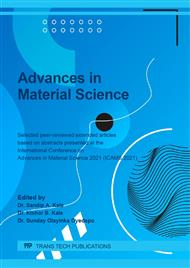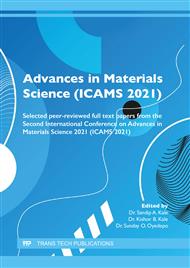[1]
M. Perno, L. Hvam, and A. Haug, Implementation of digital twins in the process industry: A systematic literature review of enablers and barriers,, Comput. Ind. 134 (2022) 103558.
DOI: 10.1016/j.compind.2021.103558
Google Scholar
[2]
S. E. Singh, E. Shehab, N. Higgns, K. Fowler, T. Tomiyama, C. Fowler, Challenges of Digital Twin in High Value Manufacturing., [Online]. Available at: https://research.nu.edu.kz/en/publications/challenges-of-digital-twin-in-high-value-manufacturing , 2018. Accessed 10th October, (2021).
DOI: 10.4271/2018-01-1928
Google Scholar
[3]
F. J. Kahlen, S. Flumerfelt, and A. Alves, Transdisciplinary perspectives on complex systems: New findings and approaches, Springer, August (2017).
DOI: 10.1007/978-3-319-38756-7
Google Scholar
[4]
R. Wagner, B. Schleich, B. Haefner, A. Kuhnle, S. Wartzack, and G. Lanza, Challenges and potentials of digital twins and industry 4.0 in product design and production for high performance products,, Procedia CIRP, 84 (2019) 88–93.
DOI: 10.1016/j.procir.2019.04.219
Google Scholar
[5]
K. Y. H. Lim, P. Zheng, and C. H. Chen, A state-of-the-art survey of Digital Twin: techniques, engineering product lifecycle management and business innovation perspectives,, J. Intell. Manuf. 31.6 (2020) 1313–1337.
DOI: 10.1007/s10845-019-01512-w
Google Scholar
[6]
S. A. Hadigheh, Y. Wei, and S. Kashi, Optimisation of CFRP composite recycling process based on energy consumption, kinetic behaviour and thermal degradation mechanism of recycled carbon fibre,, J. Clean. Prod., 292 (2021) 125994.
DOI: 10.1016/j.jclepro.2021.125994
Google Scholar
[7]
R. Geiger, Y. Hannan, W. Travia, R. Naboni, and C. Schlette, Composite wind turbine blade recycling - Value creation through Industry 4.0 to enable circularity in repurposing of composites,, IOP Conf. Ser. Mater. Sci. Eng. 942.1 (2020) 1–11.
DOI: 10.1088/1757-899x/942/1/012016
Google Scholar
[8]
D. Borjan, Ž. Knez, and M. Knez, Recycling of carbon fiber-reinforced composites— difficulties and future perspectives,, Materials (Basel). 14. 15 (2021) 1–13.
DOI: 10.3390/ma14154191
Google Scholar
[9]
A. Meiirbekov, E. Shehab, A. Amantayeva, A. Suleimen, S. Tokbolat, and S. Sarfraz, Understanding uncertainty in recycling carbon fiber reinforced composites,, Adv. Transdiscipl. Eng. 15 (2021) 166–171.
DOI: 10.3390/polym13234208
Google Scholar
[10]
K. Korniejenko, B. Kozub, A. Bąk, P. Balamurugan, M. Uthayakumar, and G. Furtos, Tackling the circular economy challenges—composites recycling: Used tyres, wind turbine blades, and solar panels,, J. Compos. Sci. 5.9 (2021) 1–18.
DOI: 10.3390/jcs5090243
Google Scholar
[11]
A. Meiirbekov, A. Amantayeva, S. Tokbolat, A. Suleimen, S. Sarfraz, and E. Shehab, Carbon Fiber Composites Application and Recycling in Kazakhstan and Neighboring Countries,, The 28th International Conference on Transdisciplinary Engineering, 5 -9 July 2021 (TE2021), University of Bath, UK, Advances in Transdisciplinary Engineering.
DOI: 10.3233/atde210122
Google Scholar
[12]
S. Melendi-espina, C. Morris, T. Turner, and S. Pickering, Recycling of carbon fibre composites,, Carbon 2016: Penn State University, State College. no. June, p.4–7, 2016. [Online]. Available at: https://www.researchgate.net/publication/304571651_Recycling_of_carbon_fibre_composites. Accessed 5th October (2021).
Google Scholar
[13]
E. Shehab, A. Meiirbekov, and S. Sarfraz, Challenges in cost modelling of recycling carbon fiber composites, , 27th ISTE International Conference on Transdisciplinary Engineering, Warsaw University of Technology, Warsaw, Poland, Advances in Transdisciplinary Engineering, p.594–601,.
DOI: 10.3233/atde200120
Google Scholar
[14]
B. Wang, W. Zhou, and S. Shen, Garbage classification and environmental monitoring based on internet of things,, Proc. 2018 IEEE 4th Inf. Technol. Mechatronics Eng. Conf. ITOEC 2018, no. Itoec, p.1762–1766, (2018).
DOI: 10.1109/itoec.2018.8740751
Google Scholar
[15]
S. Zambal, C. Eitzinger, M. Clarke, J. Klintworth, and P. Mechin, Effects of defects analysis based on manufacturing data,, 2018 IEEE 16th Int. Conf. Ind. Informatics, p.803–808, (2018).
DOI: 10.1109/indin.2018.8472014
Google Scholar
[16]
I. Kuzminykh, B. Ghita, and J. M. Such, The challenges with internet of things for business,, arXiv, no. December, 2020. [Online]. Available at: https://arxiv.org/abs/2012.03589. Accessed 9th October (2021).
Google Scholar
[17]
C. Johnson, Impacts of Digitalization on Traceability A Case Study of the Carbon Fiber Supply Chain,, in The Digital Transformation of Logistics: Demystifying Impacts of the Fourth Industrial Revolution, IEEE Press. (2021) 311–327.
DOI: 10.1002/9781119646495.ch22
Google Scholar



